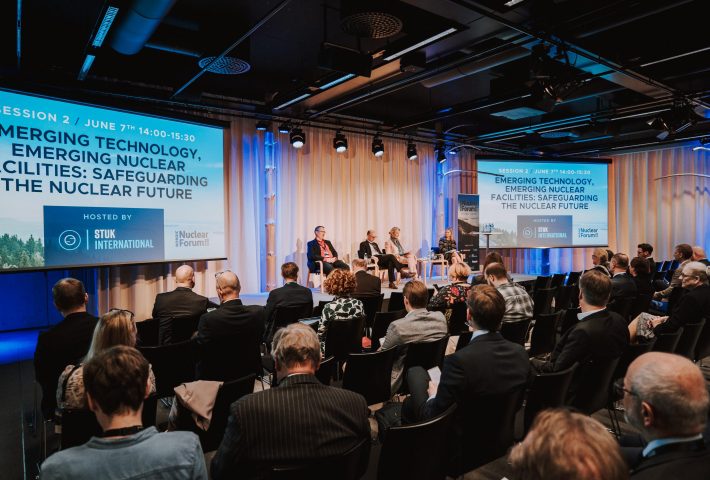
The first day of the Nordic Nuclear Forum 2022 started with a joint opening with the Nuclear Europe 2022 at Crowne Plaza. As at the joint opening was mentioned the global crisis and climate change have changed the role of nuclear energy to even more important. Especially when Finland has an ambitious goal to reach carbon neutrality by 2035. Massimo Garribba, Deputy Director-General, Department of Energy from European Commission was mentioning the future of energy among SMRs and fusion. Rafael Mariano Grossi, the Director General of IAEA also mentioned the new options and possibilities the SMRs bring and he praised the co-operation between Finland and the IAEA. “The best time to plant a tree was 20 years ago. The second-best time is now.” DG Grossi added at the joint opening.
Here are some highlights of Day 1:
- The EU target is to reach climate neutrality by 2050. In Finland the same target is by 2035. For Finland nuclear power is an important part of reliable and emission-free electricity and has potential for heat production in the future. In past few months, more than ever, the importance of our own energy production was highlighted. We have good pallet to make electricity but make it clean, sustainable and constant is the real question. The other great question is: What is sustainable? We should not only look at the environment point of view but also what is sustainability for the society? Liisa Heikinheimo, Deputy Director General, Energy Department, Ministry of Economic Affairs and Employment (Finland)
- Time management needs to improve. We cannot just accept that the projects take a lot of time and other resources. We must put our forces together and understand the reasons why projects take time. Why some countries can do things faster without compromising safety? We cannot just blame the authorities for their tight regulations because there are proofs that things can be done better. Tarik Choho, President, EMEA operating plant services, Westinghouse
- The investments alone are not enough to succeed. Key is the engagement of the full supply chain. Interaction between suppliers and designers is very important to understand all layers the production. Commitment to safety is the key, followed by quality. Nowadays the cyber threats are rising, which is something we also need to focus on. Bernard Fontana, CEO, Framatome
- We need safeguards because we are going to use nuclear energy in the EU in future, also to fulfill the climate targets by 2050. Even if we would shut down all nuclear power plants today, the nuclear material will be around for quite some time. Massimo Garribba Deputy Director-General, Department of Energy from European Commission
- Biggest challenge and opportunities in emerging technologies and safeguards: It is important to educate and communicate transparently with the people to build confidence and trust that they and their environment are safe. Understanding their concerns helps to understand the steps we need to take to build the confidence. We can show people first-hand how things are done with the tours to the facilities and educate them with the international guidance and regulations and that we live up to them. There is still a lot to do in the future to educate people and help to build confidence and trust. Liza Frizzell VP for Communications NWMO (Canada)
- IAEA works for the safe, peaceful, and secure use of nuclear technology. Safeguard implementations is made in co-operation with the Member States and companies. For safeguards, rules are the same for all non-nuclear weapon Member States. Jenni Rissanen, Team Leader, Strategic Planning Team, Dept of Safeguards, IAEA
- Nuclear is beautiful because it can save our planet. The climate problem is very much about energy, but the main issue is the emissions. Few recommendations to reach clean energy transition: better access to finance, extensions of lifetime and including green hydrogen. Kirsty Gogan, Founder and Managing Director at TerraPraxis, Managing Director at LucidCatalyst.
- We need to realise that we need all sources of green energy: wind, hydro, solar and nuclear. We need to understand the benefits of other technologies so we can learn from each other and co-operate. We also need more women to the industry. We need to make the industry more attractive for women to build role models for the younger generation. Christopher Eckerberg, Vice President Nuclear Decommissioning, Vattenfall.
- Financing can be one of the biggest issues in improving nuclear competitiveness, but we need to remember that nuclear can be cheap. How to get the rates low to fund nuclear? In the past the governments have been shy sharing the risk of nuclear power. That has now been slowly changing and the private and public sectors can work in co-operation. On the other hand the companies behind building the nuclear power plants need visibility to invest in their facilities. This visibility can be provided by the governments. So, visibility and sharing risk, these would drive both rates down which will raise the competitiveness. Vakis Ramany Senior VP, International Nuclear Development, EDF.
Photo by Jussi Paakkinen




